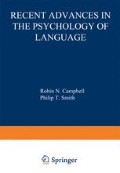Abstract
This paper is a first report on a longitudinal study of the acquisition of a syntactic rule: the inversion of WH-questions.1 The general aim of this presentation is to show how certain modifications in the theory and practice of linguistics can contribute to the study of acquisition, and to the psychology of language generally. These new developments spring from an approach to linguistic analysis that is based on the observation of speech in every-day contexts, and experiments carried out in every-day situations. In this approach, introspection may be taken as a handy guide to the issues, but not as evidence for the developing theory.
Access this chapter
Tax calculation will be finalised at checkout
Purchases are for personal use only
Preview
Unable to display preview. Download preview PDF.
References
Bickerton, D. (1971). Inherent variability and variable rules. Foundations of Language, 7, 457–492.
Bloom, L. (1970). Language Development: Form and Func tion in Emerging Grammars. Cambridge, Mass.: MIT Press.
Bloomfield, L. (1926). A set of postulates for the science of language. Language, 2 ,153–164.
Brown, R. (1973). A first language: the early stages. Cambridge, Mass.: Harvard University Press.
Butters, R.R. (1971). On the notion ’rule of grammar’ in dialectology. Papers from the Seventh Regional Meeting of the Chicago Linguistic Society. Chicago: Department of Linguistics, University of Chicago.
Cedergren, H., and Sankoff, D. (1974). Variable rules: performance as a statistical reflection of competence. Language, 50, 333–355.
Chomsky, N. (1965). Aspects of the Theory of Syntax. Cambridge, Mass.: MIT Press.
Guy, G. (1975). Variation in the group and the individual: the case of final stop deletion. Pennsylvania Working Papers on Linguistic Change and Variation, 1:4. Philadelphia: U.S. Regional Survey.
Lahov, W. (1963). The social motivation of a sound change. Word. 19, 273–309.
Labov, W. (1969). Contraction, deletion, and inherent variability of the English copula. Language, 45, 715–762.
Labov, W. (1972). Where do grammars stop? In R. Shuy (ed.) Georgetown Monograph on Language and Linguistics, 25, 43–88.
Labov, W.,Cohen, P., Robins, C, and Lewis, J. (1968). A study of the non-standard English of Negro and Puerto Rican speakers in New York City. Cooperative Research Report 3288. Vols. I and II. New York: Columbia University.
Labov, W., and Labov, T. (1974). The grammar of catand mama. Paper given before the Linguistic Society of America, New York City, December 1974.
Lakoff, G. (1970). Global rules. Language,46, 627–639.
Ravem, R. (1974). The learning of WH-questions. In Richards, J.C. (ed.) Error Analysis: Perspectives on Second Language Acquiaition. London: Longmans.
Shatz, M., and Gelman, R. (1973). The development of communication skills: modifications in the speech of young children as a function of listener. Monographs of the Society for Research in Child Development, 38:5.
Solomon, R.L., and Howes, D.H. (1951). Word frequency, personal values and visual duration thresholds. Psychological Review, 58, 256–270.
Solomon, R.L., and Postman, L. (1952). Frequency of usage as a determinant of recognition threshholds for words. Journal of Experimental Psychology, 42, 195–201.
Summerlin, N.C. (1972). A dialect study: affective parameters in the deletion and substitution of consonants in the deep South. Unpublished Florida State University dissertation.
Weinreich, U., Labov, W., and Herzog, M. (1968). Empirical foundations for a theory of language change. In Lehmann, W., and Malkiel, Y. (eds.) Directions for Historical Linguistics. Austin, Tex.: University of Texas Press.
Author information
Authors and Affiliations
Editor information
Editors and Affiliations
Rights and permissions
Copyright information
© 1978 Plenum Press, New York
About this chapter
Cite this chapter
Labov, W., Labov, T. (1978). Learning the Syntax of Questions. In: Campbell, R.N., Smith, P.T. (eds) Recent Advances in the Psychology of Language. NATO Conference Series, vol 4b. Springer, Boston, MA. https://doi.org/10.1007/978-1-4684-2532-1_1
Download citation
DOI: https://doi.org/10.1007/978-1-4684-2532-1_1
Publisher Name: Springer, Boston, MA
Print ISBN: 978-1-4684-2534-5
Online ISBN: 978-1-4684-2532-1
eBook Packages: Springer Book Archive

